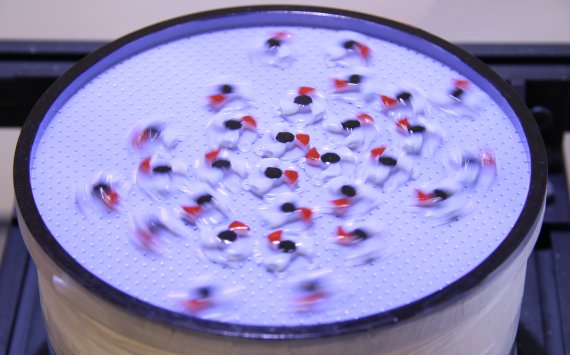©Marcel Workamp
Everyone is familiar with the fascinating swarming patterns of a flock of birds in the air. But how do the birds determine their collective course? ‘The individual birds see and feel their immediate surroundings, but they have no idea where the flock is headed,’ says Joshua Dijksman, lecturer in Physical Chemistry and Soft Matter. ‘I wanted to know what leads to the birds’ collective behaviour.’
Discs
To do this, he developed a model together with student Marcel Workamp and colleagues from North Carolina State University. They used a 3D printer to make circular discs with holes in that Dijksman then let ‘float’ above a circular table with holes through which air is expelled. Shaped holes in the discs meant that they started rotating automatically. ‘The discs have rotational but not lateral kinetic energy; they can only move forward after a collision,’ explains Dijksman.
Water movements
This model is similar to the situation for a flock of birds or shoal of fish, in which the birds adjust the direction of flight or fish the direction in which they are swimming if they feel a fellow bird or fish close by due to air or water movements. ‘The animals never collide. We think they anticipate based on air or water flows. Our results show this could be the mechanism controlling swarming.’
Friction
Dijksman designed the ventilation channels in the discs such that they rotate anticlockwise. When there were only a few discs, they tended to collide with the outer wall on their anticlockwise-moving edges, which made them rotate collectively in a clockwise sense. But when there were larger numbers, they collided more frequently with each another, edge to edge, and that eventually led them to all move in an anticlockwise sense. ‘Friction is really important for swarm behaviour,’ says Dijksman.
Granular materials
Dijksman works in the Physical Chemistry and Soft Matter group. On the reason for examining swarms of active particles, he says: ‘Our group works a lot with granular materials such as coffee and sand. These materials behave in a distinctive way: sometimes they flow, sometimes they get stuck. Our American colleagues were already investigating the interaction between particles using air hockey tables. We wanted to know how active particles would influence that flow behaviour. That was when we realized that our 3D printer could print these active particles.’ The article appeared on 6 June in the journal Soft Matter.This discovery may turn out to be useful in the longer term. If you can understand the principles behind a flock of birds, perhaps you can make new materials, thinks the physicist.

